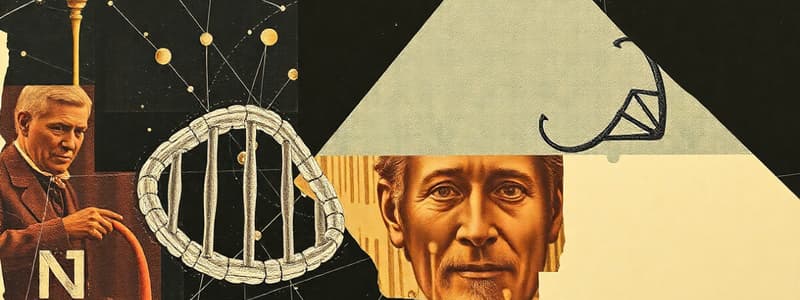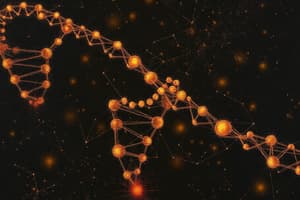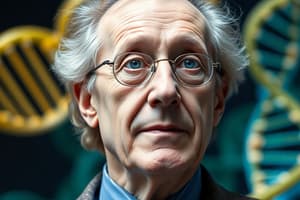Podcast
Questions and Answers
What year did Francis Crick join the Cavendish Laboratory?
What year did Francis Crick join the Cavendish Laboratory?
- 1945
- 1951
- 1949 (correct)
- 1953
Which of the following statements about James Watson's education is true?
Which of the following statements about James Watson's education is true?
- He completed his degree at Harvard University.
- He graduated with a degree in biology.
- He started university at the age of 15. (correct)
- He earned his PhD in genetics in 1950.
What major project did James Watson lead in 1989?
What major project did James Watson lead in 1989?
- The Cancer Research Project
- The Bioinformatics Initiative
- The Human Genome Project (correct)
- The Human Protein Project
In what year did Crick and Watson publish their DNA structure paper?
In what year did Crick and Watson publish their DNA structure paper?
What was one of the main fields Crick ventured into after his PhD?
What was one of the main fields Crick ventured into after his PhD?
What notable achievement occurred in 1962 for Crick and Watson?
What notable achievement occurred in 1962 for Crick and Watson?
Which statement reflects Crick's views on the genetic code?
Which statement reflects Crick's views on the genetic code?
Where did Crick relocate in 1976?
Where did Crick relocate in 1976?
What was the primary scientific method used by Crick and Watson to discover DNA's structure?
What was the primary scientific method used by Crick and Watson to discover DNA's structure?
Which of the following best describes the role of Rosalind Franklin in the discovery of DNA's structure?
Which of the following best describes the role of Rosalind Franklin in the discovery of DNA's structure?
What is a unique feature of DNA's composition identified by Crick and Watson?
What is a unique feature of DNA's composition identified by Crick and Watson?
What timeframe was noted for determining the final structure of DNA after multiple models were attempted?
What timeframe was noted for determining the final structure of DNA after multiple models were attempted?
Which statement correctly reflects the impact of Crick and Watson's discovery on scientific research?
Which statement correctly reflects the impact of Crick and Watson's discovery on scientific research?
What role did Erwin Chargaff play in the understanding of DNA structure?
What role did Erwin Chargaff play in the understanding of DNA structure?
Which key event aided Crick and Watson in confirming the double helix model of DNA?
Which key event aided Crick and Watson in confirming the double helix model of DNA?
What was a significant contribution of Rosalind Franklin in the discovery of DNA?
What was a significant contribution of Rosalind Franklin in the discovery of DNA?
What unique feature of the DNA structure did Watson and Crick determine?
What unique feature of the DNA structure did Watson and Crick determine?
How are the 'rungs' of the DNA double helix structured?
How are the 'rungs' of the DNA double helix structured?
What was the relationship dynamic between Rosalind Franklin and Maurice Wilkins during their research?
What was the relationship dynamic between Rosalind Franklin and Maurice Wilkins during their research?
Which of the following best describes the impact of Crick and Watson's discovery on genetics?
Which of the following best describes the impact of Crick and Watson's discovery on genetics?
What materials were used by Crick and Watson to build their famous 3D model of DNA?
What materials were used by Crick and Watson to build their famous 3D model of DNA?
Flashcards
What is DNA's structure?
What is DNA's structure?
A fundamental building block of life, composed of two long chains of nucleotides twisted into a double helix.
Where was the DNA structure published?
Where was the DNA structure published?
In 1953, Crick and Watson published their discovery of DNA's double helix structure in the scientific journal Nature.
Where did Crick and Watson work together?
Where did Crick and Watson work together?
Francis Crick and James Watson collaborated at the Cavendish Laboratory in Cambridge, England, to research DNA's structure.
What award did Crick and Watson receive?
What award did Crick and Watson receive?
Signup and view all the flashcards
What did Crick study after his PhD?
What did Crick study after his PhD?
Signup and view all the flashcards
What project did Watson lead?
What project did Watson lead?
Signup and view all the flashcards
What academic background did Crick have?
What academic background did Crick have?
Signup and view all the flashcards
What was Watson's PhD research focus?
What was Watson's PhD research focus?
Signup and view all the flashcards
What are the chemical bases of DNA?
What are the chemical bases of DNA?
Signup and view all the flashcards
How did Crick and Watson discover DNA's structure?
How did Crick and Watson discover DNA's structure?
Signup and view all the flashcards
Who contributed to the discovery of DNA's structure?
Who contributed to the discovery of DNA's structure?
Signup and view all the flashcards
How does DNA's structure enable replication?
How does DNA's structure enable replication?
Signup and view all the flashcards
What does DNA's structure resemble?
What does DNA's structure resemble?
Signup and view all the flashcards
What base pairing rules govern DNA?
What base pairing rules govern DNA?
Signup and view all the flashcards
How does DNA code for genetic information?
How does DNA code for genetic information?
Signup and view all the flashcards
How does DNA replicate?
How does DNA replicate?
Signup and view all the flashcards
How did Franklin contribute to the discovery of DNA's structure?
How did Franklin contribute to the discovery of DNA's structure?
Signup and view all the flashcards
What did Crick and Watson use to create their DNA model?
What did Crick and Watson use to create their DNA model?
Signup and view all the flashcards
What impact did the discovery of DNA's structure have?
What impact did the discovery of DNA's structure have?
Signup and view all the flashcards
What recognition did Crick, Watson, and Wilkins receive for their discovery?
What recognition did Crick, Watson, and Wilkins receive for their discovery?
Signup and view all the flashcards
Study Notes
Francis Crick
- Nobel Prize winner, British biophysicist
- Joint 1953 discovery of DNA structure
- Studied physics at University College London
- Worked on magnetic and acoustic mines during WWII
- Joined Cavendish Laboratory in 1949, Cambridge
- PhD on X-ray diffraction of proteins in 1951
- Collaborated with James Watson
- Discovered DNA's molecular structure in 1954
- Contributed to genetic code study
- Moved to California in 1976, studied developmental neurobiology and human consciousness.
- Key quote "The genetic code is...the key to molecular biology", 1966
- Started PhD at the Cavendish Laboratory in 1949
- Published a landmark paper on DNA structure in Nature, April 25, 1953
- Built 3D models to try and replicate DNA's structure
James Watson
- US geneticist and biophysicist, Nobel Prize winner
- Discovered DNA double helix structure with Crick
- University of Chicago aged 15, zoology degree in 1947
- PhD in virus research at the Cavendish Laboratory, 1950
- Formed productive partnership with Crick
- Published groundbreaking paper on DNA structure
- Moved to California then returned to Cavendish for work with Crick
- Lectured at Harvard, professor of biology in 1960
- Published biological texts
- Led Human Genome Project in 1989
- Key quote: "In science there is only one answer and that has to be correct", 1987
- Started at the University of Chicago, age 15.
- Completed his PhD in viruses in 1950 at the Cavendish Laboratory in Cambridge
- Took part in building 3D models of the DNA molecule.
Studying That Suits You
Use AI to generate personalized quizzes and flashcards to suit your learning preferences.
Description
Explore the monumental contributions of Francis Crick and James Watson in the discovery of the DNA structure. This quiz covers their academic backgrounds, significant collaborations, and lasting impacts on molecular biology. Test your knowledge of their groundbreaking work and achievements.





